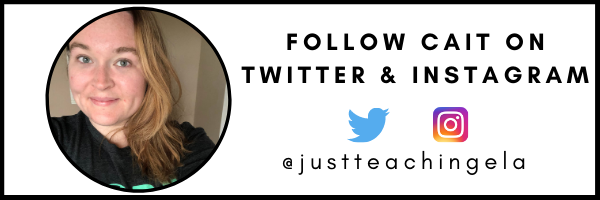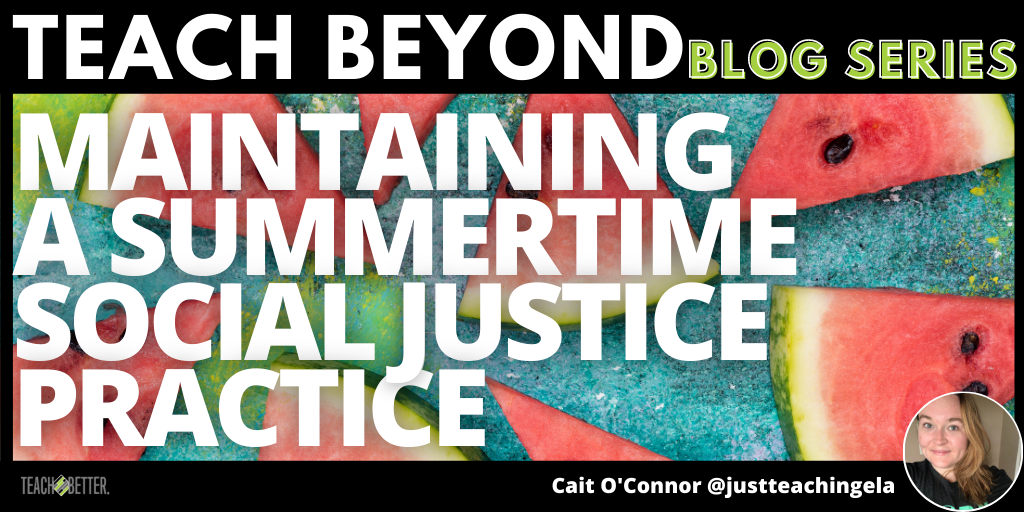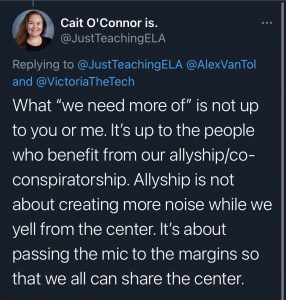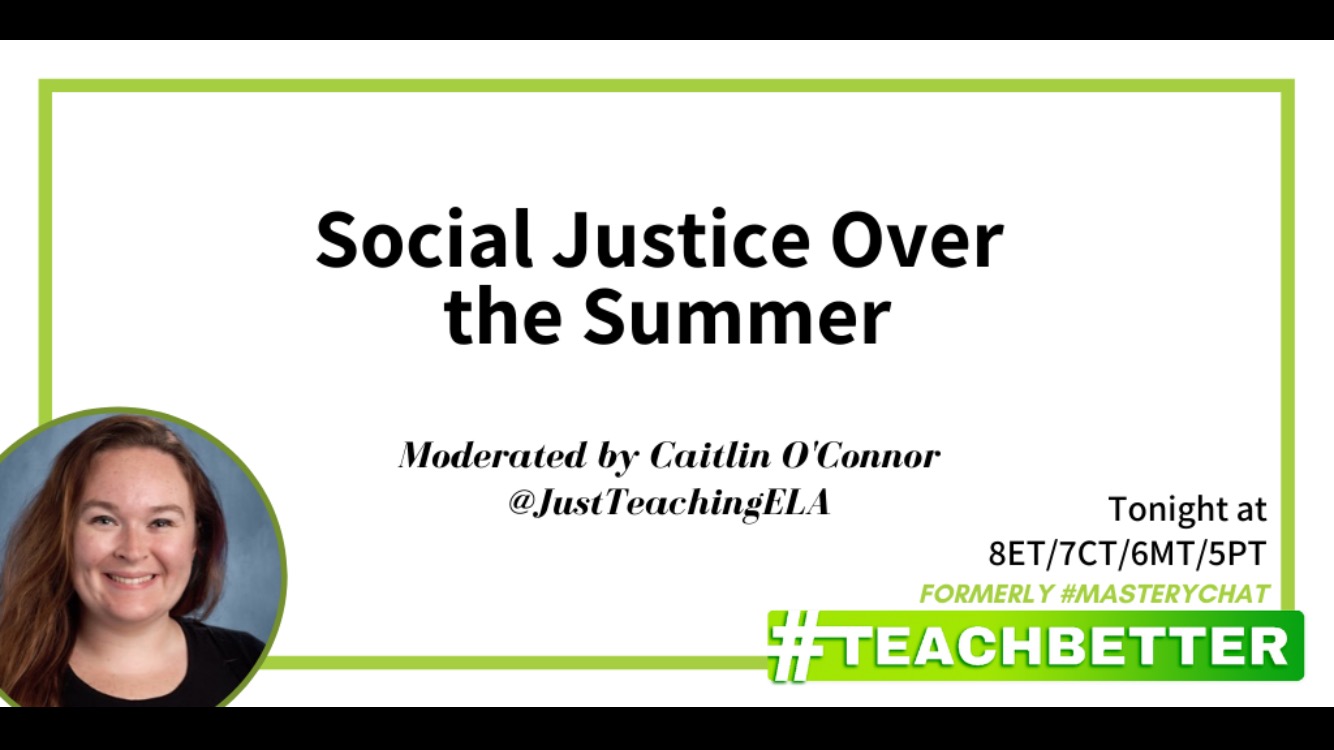TL;DR:
- Social justice work is about consistent commitment and action.
- Reflect, disrupt, and teach to maintain a social justice practice this summer.
Summer is a time when teachers rest, relax, and catch up on the reading we didn’t get to do during the school year (or is that just me?). Most teachers, even through summer, spend time planning for the year ahead (again, is it just me?).
For teachers committed to creating and sustaining a socially just classroom, “the work” does not stop in June. “The work” has become an amorphous idea meant to signify the umbrella of all that social justice education is: the learning, unlearning, relearning, and thinking/doing/being processes that social justice entails. Social justice work is, simply, committing to what bell hooks calls “education as the practice of freedom.”
One Year Later
Just over a year ago, folks spread and showed their solidarity with Black lives by posting black squares on their social media account. This was a popular trend to raise awareness and make space for creators directly impacted by racist violence to raise their voices and share resources, mutual aid, and education to their followers and beyond.
In the sea of black squares, it was hard to tell who was truly committed to change on a tangible and visceral level, and whose solidarity was performative or temporary. A year later, it’s not so hard to tell, especially because so much…just hasn’t changed.
And even without seeing black squares, signage, making commitments or hearing platitudes, our students know who their allies are, too. Not because we claim to be allies or anti-racist; but because we act like it.
By no means is any teacher, anywhere, anytime, going to get social justice exactly perfect. We all have intersections that prevent us from seeing all things, all margins, all of the time. Having an awareness is just as important as what you do with it. Working among colleagues who have that awareness makes change much easier.
Justice sounds like laughter and joy and learning happening all at the same time. Justice looks like teaching students the whole truth; the stories and people and events that make up a complete history of their lives. Justice is… Click To TweetKnow and Do.
Part of the thinking/doing/being process (described by Sonya Renee Taylor in her book The Body is Not an Apology) is, at least for me, learning how to translate new thoughts, ideas, and values into action. As I’ve stated in previous posts and in interviews with Punk Rock Classrooms, so many allies are afraid of doing something before knowing everything. I push back against this and encourage people to know while they do. Learn while you act. Show up, ask where you can help; then, go there, and do that.
Educators and academics are inclined to start with the book club and with reading. This is, of course, an important step for a few reasons. One, it allows people to become oriented in the issue at hand (racism/social injustice), and what the people being affected by it (Black folks, Latinx folks, indigenous folks, AAPI folks, disabled folks, immigrants, higher weight folks, LGBTQIA+ folks, and on) have to say on the matter. Two, it enables folks to follow the lead of the people who are actually experiencing the problem, and amplify their voices by supporting, reflecting on, and being guided by their work. But book clubs alone are an incomplete step.
The Journey
While reading, we have to always be keeping in mind the question of “What’s next?” What do we plan to do with the information we know? How can we use the power we do have to make the solutions that people like Crenshaw, Lorde, Baldwin, Nikole Hannah-Jones, Alice Wong, and Imani Barbarin (and more) have made their lives’ work?
Reading, books, and book clubs should serve as a stopgap between knowing and doing. If we theorize too much, we merely add layers onto them, ending up with a pile of unresolved harm, trauma, and oppression we still need to fix as a collective community and culture. Making visceral struggles academic also supports gatekeeping, a contest of “I know this person’s work/book/essay/life because I’ve studied it.”
All this detracts from “the work.” It also keeps us in a bubble of people who, more or less, share the same values and knowledge. Change requires conversations with people who may not be in the same place, and a shared journey to make things better and more just for all. That journey will not yield an ‘arrival,’ rather a shift in the climate and conditions of the collective journey (life!).
Reflect
It is known that a true test of one’s knowledge is their ability to teach it to others. If you’re doing some social justice reading this summer, talk about it with folks of all political, cultural, and professional backgrounds. Dialogue is key to creating and sustaining change, and simultaneously changing minds and policy. Reflecting on what we know out loud is an action. From here, feedback and metacognition—bringing the internalized information you read to the outside—will help form action.
Reflection does not immediately feel like doing a whole lot to contribute to the solution, but that’s because it’s not necessarily a ‘step’ as it is an ‘extra-curricular.’ We must reflect while we are acting, disrupting, listening, learning, doing, and being.
The thing about “the work” is that there are different roles and ways we can use the power we do have. Being the loudest, most well-read or the most popular person does not mean we are doing “the work.” It’s similar to the feeling I promise we all know: that one kid who participates in class and does all the labor, while other kids coast and zone out. This becomes an echo chamber for one person’s ideas and experiences, rather than a collaborative, community-oriented, collective journey.
Disrupt
From personal and collaborative reflection, we can begin to disrupt. This word is one we tend to hold negatively, even using it to describe students in our own classrooms. To disrupt means “to prevent something, especially a system, process, or event, from continuing as usual.” But what about systems, practices, and behaviors that need disrupting? What is our role in shifting away from compliance and toward liberation within the school community?
Start in the same place where this word is found in schools: about students. By whose standards are they disruptive? What systems define, create, and control the narrative about disruption and what we must do about it? How do values, culture, and ideas create this tension in a classroom space? What elements of these values/ideas contain remnants of dominance and power struggle, as opposed to education as the practice of freedom?
With this in mind, I consistently start every school year or new teaching experience with community agreements. I ask students to reflect on their values and answer a series of questions that will help guide them toward creating standards of behavior, academic success, and practices derived directly from who is in the room.
This action in and of itself disrupts the way education is set up: enter the space, receive a list of expectations, learn information from the front of the room, exit the space. Students design their experience on a daily basis from day one. This disruption, in my experience, always jars them; they often don’t know what to do or how to go about creating agreements. It feels very meta. But there is a process, and it works to create an embodied community.
[scroll down to keep reading]
A Longer Table
Stand up for marginalized or silenced students and community members. Provide space for their voices and stories.
The latter suggestion may mean that allies need to move their seat at the table. Ever heard the quote, “Build a longer table, not a taller fence?” It doesn’t excuse them from the table; it just adds more chairs and extends the table so that more folks can fit.
Since “the work” in its true form is not ego-driven but people- and progress-driven, accepting that our role as ally is secondary to the role of those impacted by oppression is difficult (because…ego) and necessary (because…progress). It may feel tempting or easy to say “what we need is…” As allies and accomplices (who likely have privileges that those who experience oppressive systems do not), it is our job to show up with our strengths, take the direction needed to make change, then go out there and get that change done, using the skills we bring to the table.
Teach
In your own individual classroom, action can look many different ways. Avoiding colorblindness or other sorts of bypassing (“I’m kind to all my students/treat all my students the same”) is imperative. We must see our students and their realities in order to teach them. Kindness is the standard and should be constant and present in every classroom; however, kindness is not synonymous with justice.
Justice sounds like laughter and joy and learning happening all at the same time. Justice looks like teaching students the whole truth; the stories and people and events that make up a complete history of their lives. Justice is trusting each student to know themselves best.
This is what I love most about being an English educator! The capacity to see multiple historical events from the places and people who encountered them, and all that they brought with them to those experiences…that’s the art of story and the art of truth. It is students seeing themselves and each other in the books they read, the stories they write, and even the math problems they solve. Curriculum is only as immutable as the folks who write and implement it; it can change as we change. So can the agreements you adapt with students throughout the year.
I’m totally aware that there are more barriers to change than I could possibly articulate here. After all, schools are full of different people, principles, and personalities. But the goal is and should remain the same: educate students in the present, prepare them for the future, and do both of these things while honoring that they are intelligent, independent, and deserve truth. Both matter. Being present in our classroom allows us to pause and recognize what is important to us personally and collectively, and decide what kind of future we want, together.
Tools/Resources:
Crenshaw, Kimberle. “On Intersectionality: Essential Writings” 2017. https://scholarship.law.columbia.edu/books/255
Delpit, Lisa. Teaching When the World is on Fire. 2019.
hooks, bell. Teaching Community: A Pedagogy of Hope. Routledge, 2003.
Kendi, Ibram X., and Jason Reynolds. Stamped. Little, Brown & Company, 2020.
Lorde, Audre. “Transforming Silence into Language and Action”. Originally published in 1979.
Taylor, Sonya Renee. The Body is Not an Apology. 2nd ed. 2021.
Join me this Thursday, July 22nd, for a #TeachBetter chat on this topic! We kick off at 8pm EST.
About Cait O’Connor
Cait O’Connor is a fourth-year public school English/ESOL educator in New York, committed to social justice and equity in education and beyond.




